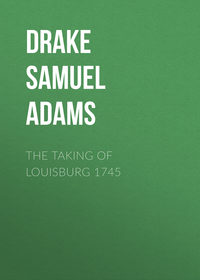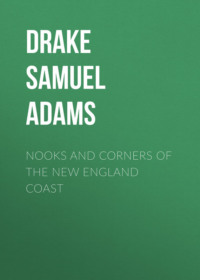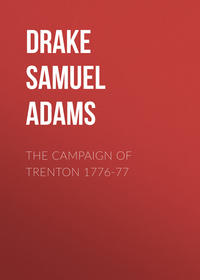 полная версия
полная версияBurgoyne's Invasion of 1777

Samuel Adams Drake
Burgoyne's Invasion of 1777 With an outline sketch of the American Invasion of Canada, 1775-76
INTRODUCTION
Among the decisive events of the Revolutionary struggle, Burgoyne's campaign deservedly holds the foremost place, as well for what it led to, as for what it was in inception and execution – at once the most daring, most quixotic, and most disastrous effort of the whole war.
Burgoyne was himself, in some respects, so remarkable a man that any picture of his exploits must needs be more or less tinted with his personality. And this was unusually picturesque and imposing. He acquired prestige, at a time when other generals were losing it, through his participation in Carleton's successful campaign. But Burgoyne was something more than the professional soldier. His nature was poetic; his temperament imaginative. He did nothing in a commonplace way. Even his orders are far more scholarly than soldier-like. At one time he tells his soldiers that "occasions may occur, when nor difficulty, nor labor, nor life are to be regarded" – as if soldiers, in general, expected anything else than to be shot at! – at another, we find him preaching humanity to Indians, repentance to rebels, or better manners to his adversary, with all the superb self-consciousness that was Burgoyne's most prominent characteristic.
To the military critic, Burgoyne's campaign is instructive, because it embodies, in itself, about all the operations known to active warfare. It was destined to great things, but collapsed, like a bubble, with the first shock of an adverse fortune.
This campaign is remarkable in yet another way. It has given us the most voluminous literature extant, that treats of any single episode of the Revolutionary War. In general, it takes many more words to explain a defeat than to describe a victory. Hence this fulness is much more conspicuous upon the British than upon the American side of the history of this campaign. Not only the general, who had his reputation to defend, but high officials, whose guiding hand was seen behind the curtain, were called to the bar of public opinion. The ministers endeavored to make a scapegoat of the general; the general, to fix the responsibility for defeat upon the ministers. His demand for a court-martial was denied. His sovereign refused to hear him. It was thus meanly attempted to turn the torrent of popular indignation, arising from the ill success of the expedition, wholly upon the unlucky general's head. Burgoyne's heroic persistency at length brought the British nation face to face with the unwelcome fact, which the ministers were so desirous of concealing, – that somebody besides the general had blundered; and if the inquiry that Burgoyne obtained from Parliament failed to vindicate him as a captain, it nevertheless did good service by exposing both the shortcomings of his accusers, and the motives which had guided their conduct with respect to himself.
Besides the official examination by the House of Commons, we have several excellent narratives, written by officers who served with Burgoyne, all of which materially contribute to an intelligent study of the campaign, from a purely military point of view. These narratives are really histories of the several corps to which the writers belonged, rather than capable surveys of the whole situation; but they give us the current gossip of the camp-fire and mess-table, spiced with anecdote, and enlivened with the daily experiences through which the writers were passing. And this is much.
In his defence, General Burgoyne vigorously addresses himself to the four principal charges brought forward by his accusers: namely, first, of encumbering himself with a needless amount of artillery; secondly, of taking the Fort Anne route, rather than the one by way of Lake George; thirdly, of sending off an expedition to Bennington, under conditions inviting defeat; and, lastly, of crossing the Hudson after the disasters of Bennington and Fort Stanwix had taken place.
The real criticism upon Burgoyne's conduct, so far as it relates to the movement of his forces only, seems to be that from the moment when the march was actually to begin, he found himself in want of everything necessary to a rapid advance. Thus, we find him scarcely arrived at Skenesborough before he is asking Sir Guy Carleton for reënforcements to garrison Ticonderoga and Fort George with, to the end that his own force might not be weakened by the detachments required to hold those fortresses against the Americans, when he should move on. It would seem that this contingency, at least, might have been foreseen before it forced itself upon Burgoyne's attention. Yet it was of so serious a nature, in this general's eyes, that he expresses a doubt whether his army would be found equal to the task before it, unless Carleton would assume the defence of the forts referred to above.
At this time, too, the inadequacy of his transportation service became so painfully evident, that the expedition to Bennington offered the only practicable solution to Burgoyne's mind.
These circumstances stamp the purposed invasion with a certain haphazard character at the outset, which boded no good to it in the future.
Carleton having declined to use his troops in the manner suggested, Burgoyne was compelled to leave a thousand men behind him when he marched for Albany. Carleton, the saviour of Canada, was justly chagrined at finding himself superseded in the conduct of this campaign, by an officer who had served under his orders in the preceding one; and, though he seems to have acted with loyalty toward Burgoyne, this is by no means the only instance known in which one general has refused to go beyond the strict letter of his instructions for the purpose of rescuing a rival from a dilemma into which he had plunged with his eyes wide open.
The Prelude with which our narrative opens, undertakes first, to briefly outline the history of the Northern Army, which finally brought victory out of defeat; and next, to render familiar the names, location, and strategic value of the frontier fortresses, before beginning the story of the campaign itself.
Few armies have ever suffered more, or more nobly redeemed an apparently lost cause, than the one which was defeated at Quebec and victorious at Saratoga. The train of misfortunes which brought Burgoyne's erratic course to so untimely an end was nothing by comparison. And the quickness with which raw yeomanry were formed into armies capable of fighting veteran troops, affords the strongest proof that the Americans are a nation of soldiers.
So many specific causes have been assigned for Burgoyne's failure, that it is hardly practicable to discuss all of them within reasonable limits. The simplest statement of the whole case is that he allowed himself to be beaten in detail. It seems plain enough that any plan, which exposed his forces to this result, was necessarily vicious in itself. Moreover, Burgoyne wofully misestimated the resources, spirit, and fighting capacity of his adversary. With our forces strongly posted on the Mohawk, St. Leger's advance down the valley was clearly impracticable. Yet such a combination of movements as would bring about a junction of the two invading columns, at this point, was all essential to the success of Burgoyne's campaign. To have effected this in season, Burgoyne should have made a rapid march to the Mohawk, intrenched himself there, and operated in conjunction with St. Leger. His delays, attributable first, to his unwise choice of the Fort Anne route, next, to Schuyler's activity in obstructing it, and lastly, to his defeat at Bennington, gave time to render our army so greatly superior to his own, that the conditions were wholly altered when the final trial of strength came to be made.
What might have happened if Sir W. Howe had moved his large army and fleet up the Hudson, in due season, is quite another matter. The writer does not care to discuss futilities. In the first place, he thinks that Burgoyne's campaign should stand or fall on its own merits. In the next, such a movement by Howe would have left Washington free to act in the enemy's rear, or upon his flanks, with a fair prospect of cutting him off from his base at New York. Of the two commanders-in-chief, Washington acted most effectively in reënforcing Gates's army from his own. Howe could not and Carleton would not do this. From the moment that Burgoyne crossed the Hudson, he seems to have pinned his faith to chance; but if chance has sometimes saved poor generalship, the general who commits himself to its guidance, does so with full knowledge that he is casting his reputation on the hazard of a die. As Burgoyne did just this, he must be set down, we think, notwithstanding his chivalrous defence of himself, as the conspicuous failure of the war. And we assume that the importance which his campaign implied to Europe and America, more than any high order of ability in the general himself, has lifted Burgoyne into undeserved prominence.
PRELUDE
I.
THE INVASION OF CANADA, 1775
Canada's attitude.England took Canada from France in 1759, and soon after annexed it to her own dominions. Twelve years later, her despotic acts drove her American colonies into open rebellion. England feared, and the colonies hoped, Canada would join in the revolt against her. But, though they did not love their new masters, prudence counselled the Canadians to stand aloof, at least till the Americans had proved their ability to make head against the might of England.
That England would be much distressed by Canada's taking sides with the Americans was plain enough to all men, for the whole continent would then be one in purpose, and the conflict more equal; but the Americans also greatly wished it because all New England and New York lay open to invasion from Canada.
Nature had created a great highway, stretching southward from the St. Lawrence to the Hudson, over which rival armies had often passed to victory or defeat in the old wars. Open water offered an easy transit for nearly the whole way. A chain of forts extended throughout its whole length. Chambly and St. John's defended the passage of the Richelieu, through which the waters of Lake Champlain flow to the St. Lawrence. Crown Point1 and Ticonderoga2 blocked the passage of this lake in its narrowest part. Ticonderoga, indeed, is placed just where the outlet of Lake George falls down a mountain gorge into Lake Champlain. Its cannon, therefore, commanded that outlet also. Fort George stood at the head of Lake George, within sixteen miles of Fort Edward, on the Hudson. These were the gates through which a hostile army might sally forth upon our naked frontier. Much, therefore, depended on whether they were to be kept by friend or foe.
Ticonderoga.In natural and artificial strength, Ticonderoga was by far the most important of these fortresses. At this place the opposite shores of New York and Vermont are pushed out into the lake toward each other, thus forming two peninsulas, with the lake contracted to a width of half a mile, or point-blank cannon range, between them: one is Ticonderoga; the other, Mount Independence. Thus, together, they command the passage of the two lakes.
Ticonderoga itself is a tongue-shaped projection of quite uneven land, broad and high at the base, or where it joins the hills behind it, but growing narrower as it descends over intervening hollows or swells to its farthest point in the lake. That part next the mainland is a wooded height, having a broad plateau on the brow – large enough to encamp an army corps upon – but cut down abruptly on the sides washed by the lake. This height, therefore, commanded the whole peninsula lying before it, and underneath it, as well as the approach from Lake George, opening behind it in a rugged mountain pass, since it must be either crossed or turned before access to the peninsula could be gained. Except for the higher hills surrounding it, this one is, in every respect, an admirable military position.
The French, who built the first fortress here, had covered all the low ground next the lake with batteries and intrenchments, but had left the heights rising behind it unguarded, until Abercromby attacked on that side in 1758. They then hastily threw up a rude intrenchment of logs, extending quite across the crest in its broadest part. Yet, in spite of the victory he then obtained, Montcalm was so fully convinced that Ticonderoga could not stand a siege, that he made no secret of calling it a trap, for some honest man to disgrace himself in.3
Ticonderoga, however, was henceforth looked upon as a sort of Gibraltar. People, therefore, were filled with wonder when they heard how Ethan Allen had surprised and taken it on the 9th of May, 1775, with only a handful of men; how Seth Warner had also taken Crown Point; and how Skenesborough4 and Fort George, being thus cut off from Canada, had also fallen into our hands without firing a shot.5
Thus, in the very beginning of the war for independence, and at one bold stroke, we regained possession of this gateway of the north; or in military phrase, we now held all the strategic points by which an advance from Lower Canada upon the United Colonies was possible.
II.
THE INVASION OF CANADA
Invasion of Canada.The prompt seizure of the lake fortresses had a marked effect upon the wavering Canadians.6 Many joined us. More stood ready to do so whenever the signal for revolt should be given. Success begets confidence. The Americans were now led to believe that by throwing an army into Canada at once, the people would no longer hesitate to free themselves from the British yoke. The time seemed the riper for it, because it was known that the strong places of Canada were but weakly guarded. Could Quebec and Montreal be taken, British power in Canada would be at an end.
Our army retreats.1776.With such promise held out before it, Congress resolved to make the attempt. Forces were ordered to both places. One body, under General Montgomery,7 mustered at Ticonderoga. Ethan Allen went before it to rouse the Canadians, who were expected to receive the Americans with open arms. This army moved down the lake in October, taking St. John's and Chambly in its way, and Montreal a little later. The other, led by Colonel Arnold,8 ascended the Kennebec to its head, crossed over to the Chaudière, which was followed to the St. Lawrence, and came before Quebec at about the same time Montgomery entered Montreal. Montgomery hastened to Arnold with a handful of men. Together they assaulted Quebec on the morning of December 31. The attack failed, and Montgomery fell. The Americans lay before Quebec till spring, when the arrival of fresh troops, for the enemy, forced ours to retreat to Montreal. This, too, was abandoned. Our army then fell back toward Lake Champlain, setting fire to Chambly, and St. John's behind it. The enemy followed close, recapturing these places as our troops left them. Very little fighting took place, but the Americans were greatly disheartened by having constantly to retreat, and by the loss of many brave officers and men, who fell sick and died of the smallpox. July 1 the army finally reached Crown Point, ragged, sickly, and destitute of everything. Weakened by the loss of five thousand men and three commanders, it was no longer able to keep the field. Instead of conquering Canada, it had been driven out at the point of the bayonet. The great question now was, whether this army could hold its own against a victorious and advancing enemy.
General Gates9 took command of the army at this critical time. Convinced that he could never hope to hold both Crown Point and Ticonderoga, and knowing Ticonderoga to be much the stronger, in a military view, he decided to remove the army to that place at once. This was promptly done.10 The soldiers were set to work strengthening the old, or building new, works, under the direction of skilful engineers. Of these new works the strongest, as well as most important, because they commanded Ticonderoga itself, were those raised on the peninsula opposite the fortress on the Vermont side, which was christened Mount Independence on the day the army heard that the colonies had declared themselves free and independent.
Having thrown a bridge across the strait, between Ticonderoga and Mount Independence, the Americans waited for the enemy to come and attack them, for with such leaders as Gates and Stark they felt confident of gaining the victory.
The British were equally active on their side. After driving the Americans from Canada, they next determined to make themselves masters of Lake Champlain, recover the forts they had lost, and so gain a foothold for striking a blow at our northern colonies.
For this purpose they set about building a fleet at St. John's. Vessels were sent out from England, for the purpose, which were taken to pieces below the Chambly rapids, brought across the portage, and put together again at St. John's. By working diligently, the British got their fleet ready to sail early in October.
Well knowing the importance of keeping possession of the lake, the Americans turned Skenesborough into a dockyard, and were straining every nerve to get ready a fleet strong enough to cope with the British. As everything needed for equipping it had to be brought from the sea-coast, the British had much the advantage in this respect, yet all labored with so much zeal, that our fleet was first ready for action. Gates gave the command of it to Arnold, who had once been a sailor, and whose courage had been tried so signally under the walls of Quebec.
By the middle of August, Ticonderoga was in fighting trim. The enemy's delays had given time to make the defences so strong that an attack was rather hoped for than feared. Ignorant of the great preparations making at St. John's, the Americans also believed themselves strongest on the lake. Our fleet, therefore, went forward with confidence to the battle.
Naval battle, October 11.On the 11th of October the British flotilla was seen coming up the lake. The rival forces met at Valcour Island, and the battle began. From noon till night the combatants hurled broadsides at each other without ceasing. The British then drew off to repair damages, meaning to renew the fight in the morning. This gave Arnold a chance to slip through them unperceived, for his vessels were so badly shattered that all hope of gaining the victory was given over. He was pursued and overtaken. Near Crown Point the battle began again, but the enemy's superior forces soon decided it in his favor. Rather than surrender, Arnold ran his disabled vessels on shore, set fire to them, and with his men escaped to the woods.
Having thus cleared the lake, the British commander, Guy Carleton,11 sailed back to St. John's, leaving Ticonderoga unmolested behind him, to the great astonishment of our soldiers, who said Carleton deserved to be hanged for not following up his victory over Arnold.
BURGOYNE'S INVASION
I.
THE PLAN OF CAMPAIGN
After the British had gone back to Canada, it was thought they would return as soon as the lake should be frozen hard enough to bear artillery. But when it was found that they had gone into winter quarters, and the danger was past, part of the garrison of Ticonderoga was hurried off to Washington, who was then fighting against great odds in the Jerseys. This winter was the dark hour of the Revolution, upon which the victory at Trenton12 shed the first ray of light. So low had the American cause fallen at this time, that, but for this unlooked-for success, it is doubtful if another army could have been brought into the field.
The British were really planning to invade New York as soon as the lakes should be open again, in the spring. For this campaign great preparations were making, both in Canada and England. Quiet, therefore, reigned at Ticonderoga throughout the winter of 1776 and 1777.
General Burgoyne sailed for England in November, to lay before the king a plan for subduing the colonies in a single campaign. Burgoyne was a good soldier, popular with the army and government, brave to rashness, but vain and headstrong. He knew the Americans were not to be despised, for he had seen them fight at Bunker Hill, as well as in the campaign just closed, in which he himself had taken part; yet an easy confidence in his own abilities led Burgoyne into committing many grave errors, not the least of which was underestimating this very enemy.13
George III. wants the war pushed.Any plan that promised to put down the Americans, was sure of gaining the king's ear. Justice was never tempered with mercy in this monarch's treatment of his rebellious subjects. His heart was hardened, his hand ever ready to strike them the fatal blow. Moreover, the Americans had just now declared themselves independent of Great Britain. They had crossed their Rubicon. To crush them with iron hand was now the king's one thought and purpose. No half measures would do for him. He told his ministers, in so many words, that every means of distressing the Americans would meet with his approval. Mercenaries, savages, refugees – all who could fire a shot, or burn a dwelling, were to be enrolled under the proud old banner of the isles. No more effectual means could have been devised to arouse the spirit of resistance to the highest pitch.
Burgoyne's ambition was kindled by the hope of making himself the hero of the war. He combined the qualities of general and statesman without being great as either. He wrote and talked well, was eloquent and persuasive, had friends at court, and knew how to make the most of his opportunity. On his part, the king wanted a general badly. He had been grievously disappointed in Sir William Howe, whose victories seemed never bringing the war any nearer to an end. Burgoyne brought forward his plan at the right moment, shrewdly touched the keynote of the king's discontent by declaring for aggressive war, smoothed every obstacle away with easy assurance, and so impressed the ministers with his capacity, that they believed they had found the very man the king wanted for the work in hand.
The plan proposed for making short work of the war was briefly this: The American colonies were to be divided in two parts, by seizing the line of the Hudson River; just as in later times, the Union armies aimed to split the Southern Confederacy in two by getting possession of the Mississippi. To effect this, two armies were to act together. With one, Burgoyne was to come down the lakes from Canada, and force his way to Albany, while the other was coming up the Hudson to join him. Once these armies were united, with full control of the Hudson in their hands, New England would be cut off from the other colonies by forts and fleets, and the way laid open to crush out rebellion in what was admitted to be its cradle and stronghold.
Ever since Sir William Howe had been driven from Boston, in the spring of 1776, the opinion prevailed among American generals that, sooner or later, New England would become the battle-ground.14 This view was sustained by the enemy's seizure of Newport, in December of the same year, so that the Americans were perplexed at finding themselves threatened from this quarter, until the enemy's plans were fully developed.
St. Leger's part.There was yet another part to the plan concerted between Burgoyne and the British cabinet. It was seen that in proportion as Burgoyne moved down toward Albany, he would have the fertile Mohawk valley on his right. This valley was the great thoroughfare between the Hudson and Lake Ontario, Niagara, and Detroit. In it were many prosperous settlements, inhabited by a vigorous yeomanry, who were the mainstay of the patriot cause in this quarter. The passage to and fro was guarded by Fort Stanwix, which stood where Rome now is, and Fort Oswego, which was situated at the lake. Fort Stanwix was held by the Americans, and Oswego, by the British. Perceiving its value to the Americans not only as a granary, but as a recruiting station, and in view of the danger of leaving it on his flank, Burgoyne decided to march a force through this valley, clear it of enemies, and so effectively bring about a timely coöperation between the two branches of the expedition. Freed of fear for himself, he could materially aid in the work intrusted to his auxiliary. It followed that the Americans, with whom Burgoyne himself might be contending, would, of necessity, be greatly distressed by their inability to draw either men or supplies from the Mohawk Valley, no less than by the appearance of this force upon their own flank. The command of it was given to Colonel St. Leger, who was ordered to proceed up the St. Lawrence to Oswego, and from thence to Fort Stanwix and Albany.











